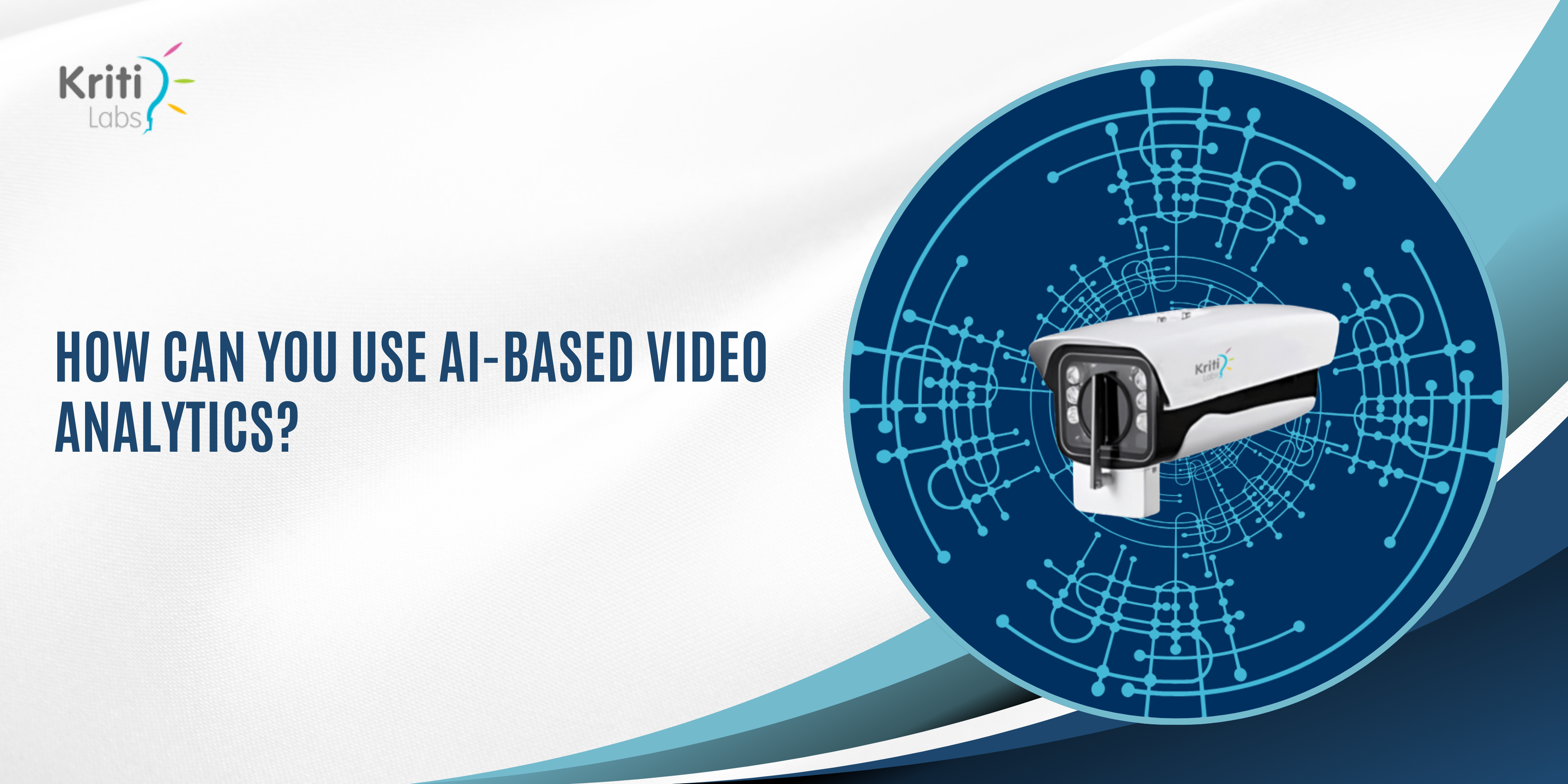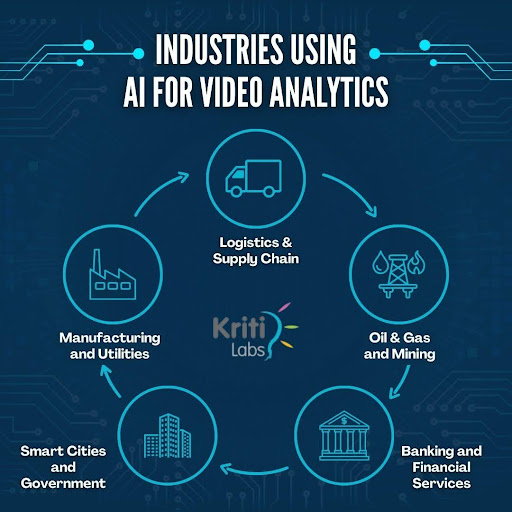How Can You Use AI-based Video Analytics?
Video data is everywhere. From warehouses and oil rigs to city intersections and factory floors,
organisations generate thousands of hours of video each day. Yet, much of it goes unused, locked
away in storage systems and reviewed only after an incident occurs. Traditional surveillance is reactive.
By the time a human operator notices something, it is often too late.
Artificial Intelligence (AI) changes that reality. With AI-based video analytics, cameras transform from
passive recorders into intelligent sensors that deliver real-time insights. Organisations no longer just
“watch” video; they gain the ability to detect, interpret, and act on critical events as they unfold.
At KritiLabs, this vision comes alive through our VAIOT Suite, which combines AI and IoT to create robust,
industry-ready solutions.
What is AI-based video analytics?
AI-based video analytics refers to the use of computer vision and deep learning to analyse live or recorded video automatically. Instead of relying on human eyes, the system detects patterns, recognises objects, interprets behaviours, and flags anomalies in real time. For businesses, this capability is not limited to security. It touches compliance, safety, operational efficiency, and even customer experience. For example, detecting an unattended asset in a restricted zone, monitoring adherence to safety gear protocols, or tracking the flow of vehicles through a logistics hub can all be automated. With KritiLabs’ VAIOT Suite, organisations integrate AI video analytics directly into their workflows. Cameras become intelligent sensors, generating insights that drive faster and more informed decisions.
Industry Use Cases
Logistics and Supply Chain-
In high-volume warehouses and distribution centres, AI-based video analytics improves visibility across loading bays, storage areas, and transport vehicles. Unauthorised access can be flagged instantly. Asset movement is tracked continuously. Video data integrates with IoT sensors for better inventory and vehicle monitoring, ensuring operational efficiency in Logistics.
-
Safety is non-negotiable in hazardous industries. VAIOT enables monitoring of restricted areas, detection of unsafe behaviour, and alerts for equipment tampering. For mining and refinery operations, AI-based video analytics reduces blind spots and enhances workforce safety.
-
For banks, security extends beyond guarding branches and ATMs. AI analytics can detect loitering near ATMs, identify unauthorised after-hours activity, and provide evidence for compliance. By integrating with IoT-based access systems, VAIOT strengthens both physical and digital layers of security.
-
Urban centres benefit immensely from AI-based video analytics. Applications range from monitoring crowd density during public events to analysing traffic flow at intersections. Automatic Number Plate Recognition (ANPR), intrusion detection in public facilities, and crowd safety alerts all improve governance and citizen safety.
-
Factories rely on AI-based video analytics to track worker movements near heavy machinery, detect when protective gear is missing, and monitor restricted zones. Compliance reporting becomes easier, and incidents can be prevented rather than just recorded.
How to Implement AI Video Analytics Effectively
Adopting AI-based video analytics isn’t just about buying “smart” cameras. It requires a structured, step-by-step approach:
- Define the problem clearly – Identify challenges such as safety compliance in railways or asset visibility in logistics.
- Choose the right deployment model – Edge, cloud, or hybrid, depending on latency, bandwidth, and privacy needs.
- Integrate with existing systems – Connect analytics with access control, IoT sensors, and enterprise dashboards.
- Set rules and detection logic – Define what constitutes an “event” (e.g., loitering near an ATM, unauthorized entry into restricted areas).
- Deploy iteratively – Start with pilots, refine thresholds, and scale gradually.
- Measure impact – Track outcomes such as reduced incidents, faster response times, and higher compliance.
Challenges and Considerations
While powerful, AI-based video analytics comes with real-world challenges:
- Data privacy & compliance – Requires secure storage, strict access control, and regulatory adherence.
- Scalability – Enterprises may need to process thousands of feeds simultaneously.
- Accuracy & false positives – Systems must be fine-tuned to reduce irrelevant alerts.
- Integration complexity – Must work seamlessly with existing monitoring and enterprise tools.
👉 KritiLabs addresses these issues through edge computing, flexible architectures, and a design-first approach prioritizing performance and compliance.
KritiLabs’ VAIOT Suite: Turning Vision into Intelligence
The VAIOT Suite is at the heart of KritiLabs’ AI-based video analytics solutions. It merges AI + IoT to convert video feeds into actionable intelligence.
Key Capabilities- Object detection & classification – Identify people, assets, or equipment.
- Real-time alerts – Instant notifications to reduce response time.
- Smart dashboards – Visual analytics for better decision-making.
- IoT integration – Combine multiple data streams into one intelligence platform.
- Scalable & flexible – Supports edge, cloud, and hybrid deployments.
Unlike generic systems, VAIOT is built for enterprise-scale, handling large logistics hubs, industrial plants, and high-risk environments.
Real-World Deployment: Protecting Railway Workers
One of KritiLabs’ most impactful deployments was with Southern Railways, ensuring worker safety during track maintenance.
The Solution- Real-time train detection
- Aural & visual alerts in local languages
- Weatherproof, portable, long-power systems
- Centralized monitoring for oversight
- Workers received timely evacuation alerts.
- Multi-track coverage reduced blind spots.
- Generated safety data for future planning.
👉 This project showcased how VAIOT transforms video into life-saving intelligence.
The Future of AI-based Video Analytics
The next leap is prediction, not just detection. By merging IoT, historical trends, and AI forecasting, systems will anticipate risks before they occur.
For industries, this means moving from:
Seeing → Understanding → Acting in real time
KritiLabs is already shaping this future with VAIOT, driving safer workplaces, smarter cities, and resilient supply chains.
📌 AI video analytics is no longer just surveillance—it’s a business enabler.
Frequently Asked Questions
1. What is AI-based video analytics?It uses AI and computer vision to automatically analyze video, detect patterns, and deliver insights.
2. How does it work?By processing video in real time with deep learning, object detection, and anomaly recognition.
3. What are the benefits?Enhanced security, higher efficiency, faster decisions, and reduced human error.
4. Which industries use it?Security, retail, manufacturing, transportation, healthcare, and smart cities.
5. What’s the future?Predictive analytics, IoT integration, smarter automation, and proactive real-time decisions.


